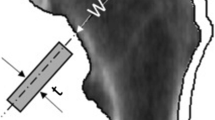Abstract
Summary
Fracture risk indices (FRIs) generated from DXA-based finite element analysis were associated with hip fracture independent of FRAX score computed with femoral neck bone mineral density (BMD). Prospective studies are warranted to determine whether FRIs represent an improvement over BMD for predicting incident hip fractures.
Introduction
The study aims to examine the association between prior hip fracture and FRIs derived from automated finite element analysis (FEA) of DXA hip scans. Femoral neck, intertrochanteric, and subtrochanteric FRIs were calculated as the von Mises stress induced by a sideways fall divided by the bone yield stress over the specified region of interest (ROI).
Methods
Using the Manitoba Bone Mineral Density Database, we selected women age ≥ 65 years with femoral neck T-scores below − 1 and no osteoporosis treatment. From this population, we identified 324 older women with hip fracture before DXA testing and a random sample of 658 non-fracture controls. FRIs were derived from the anonymized DXA scans. Logistic regression models were used to estimate odds ratios (ORs) and 95% confidence intervals (95% CIs) for the associations between FRIs (per SD increase) and hip fracture.
Results
After adjusting for FRAX score (hip fracture with BMD), femoral neck FRI (OR 1.36, 95% CI 1.13, 1.64), intertrochanteric FRI (OR 1.81, 95% CI 1.44, 2.27), and subtrochanteric FRI (OR 2.09, 95% CI 1.68, 2.60) were associated with hip fracture. Intertrochanteric and subtrochanteric FRIs gave significantly higher c-statistics (all P ≤ 0.05) than femoral neck BMD. Subgroup analyses showed that all FRIs were more strongly associated with hip fracture in women who were younger and had higher body mass index (BMI) or non-osteoporotic BMD (all P interaction < 0.1).
Conclusions
FRIs derived from DXA-based FEA were independently associated with prior hip fracture, suggesting that they could potentially improve hip fracture risk assessment.


Similar content being viewed by others
References
Burge R, Dawson-Hughes B, Solomon DH, Wong JB, King A, Tosteson A (2007) Incidence and economic burden of osteoporosis-related fractures in the United States, 2005-2025. J Bone Miner Res 22:465–475
Melton LJ 3rd, Gabriel SE, Crowson CS, Tosteson AN, Johnell O, Kanis JA (2003) Cost-equivalence of different osteoporotic fractures. Osteoporos Int 14:383–388
Randell AG, Nguyen TV, Bhalerao N, Silverman SL, Sambrook PN, Eisman JA (2000) Deterioration in quality of life following hip fracture: a prospective study. Osteoporos Int 11:460–466
Ng DCE, Lam WWC, Goh ASW (2015) Pitfalls in diagnostic radiology. Spinger, Verlag Berlin Heidelberg
Kanis JA, Borgstrom F, De Laet C, Johansson H, Johnell O, Jonsson B, Oden A, Zethraeus N, Pfleger B, Khaltaev N (2005) Assessment of fracture risk. Osteoporos Int 16:581–589
Nguyen ND, Frost SA, Center JR, Eisman JA, Nguyen TV (2008) Development of prognostic nomograms for individualizing 5-year and 10-year fracture risks. Osteoporos Int 19:1431–1444
Martin DE, Severns AE, Kabo JM (2004) Determination of mechanical stiffness of bone by pQCT measurements: correlation with non-destructive mechanical four-point bending test data. J Biomech 37:1289–1293
Majumdar S, Link TM, Millard J, Lin JC, Augat P, Newitt D, Lane N, Genant HK (2000) In vivo assessment of trabecular bone structure using fractal analysis of distal radius radiographs. Med Phys 27:2594–2599
Vanleene M, Rey C, Ho Ba Tho MC (2008) Relationships between density and Young’s modulus with microporosity and physico-chemical properties of Wistar rat cortical bone from growth to senescence. Med Eng Phys 30:1049–1056
Orwoll ES, Marshall LM, Nielson CM et al (2009) Finite element analysis of the proximal femur and hip fracture risk in older men. J Bone Miner Res 24:475–483
Luo Y (2016) A biomechanical sorting of clinical risk factors affecting osteoporotic hip fracture. Osteoporos Int 27:423–439
Christen D, Webster DJ, Muller R (2010) Multiscale modelling and nonlinear finite element analysis as clinical tools for the assessment of fracture risk. Philos Trans A Math Phys Eng Sci 368:2653–2668
Kopperdahl DL, Aspelund T, Hoffmann PF, Sigurdsson S, Siggeirsdottir K, Harris TB, Gudnason V, Keaveny TM (2014) Assessment of incident spine and hip fractures in women and men using finite element analysis of CT scans. J Bone Miner Res 29:570–580
Keaveny TM, Marshall LM, Nielson CM, Cummings SR, Hoffmann PF, Kopperdahl DL, Orwoll ES (2008) Finite element analysis of proximal femur QCT scans for the assessment of hip fracture risk in older men. J Bone Miner Res 23:S112–S112
Dragomir-Daescu D, Salas C, Uthamaraj S, Rossman T (2015) Quantitative computed tomography-based finite element analysis predictions of femoral strength and stiffness depend on computed tomography settings. J Biomech 48:153–161
Zysset P, Qin L, Lang T, Khosla S, Leslie WD, Shepherd JA, Schousboe JT, Engelke K (2015) Clinical use of quantitative computed tomography-based finite element analysis of the hip and spine in the management of osteoporosis in adults: the 2015 ISCD official positions-part II. J Clin Densitom 18:359–392
Damilakis J, Adams JE, Guglielmi G, Link TM (2010) Radiation exposure in X-ray-based imaging techniques used in osteoporosis. Eur Radiol 20:2707–2714
Luo YH, Ferdous Z, Leslie WD (2013) Precision study of DXA-based patient-specific finite element modeling for assessing hip fracture risk. Int J Numer Meth Bio 29:615–629
Luo Y, Ferdous Z, Leslie WD (2011) A preliminary dual-energy X-ray absorptiometry-based finite element model for assessing osteoporotic hip fracture risk. P I Mech Eng H 225:1188–1195
Leslie WD, Metge C (2003) Establishing a regional bone density program: lessons from the Manitoba experience. J Clin Densitom 6:275–282
Leslie WD, Caetano PA, MacWilliam LR, Finlayson GS (2005) Construction and validation of a population-based bone densitometry database. J Clin Densitom 8:25–30
Kanis JA, Oden A, Johansson H, Borgstrom F, Strom O, McCloskey E (2009) FRAX and its applications to clinical practice. Bone 44:734–743
Lix LM, Azimaee M, Osman BA, Caetano P, Morin S, Metge C, Goltzman D, Kreiger N, Prior J, Leslie WD (2012) Osteoporosis-related fracture case definitions for population-based administrative data. BMC Public Health 12:301
O’Donnell S (2013) Use of administrative data for national surveillance of osteoporosis and related fractures in Canada: results from a feasibility study. Arch Osteoporos 8:143
Naylor KE, McCloskey EV, Eastell R, Yang L (2013) Use of DXA-based finite element analysis of the proximal femur in a longitudinal study of hip fracture. J Bone Miner Res 28:1014–1021
Yang L, Palermo L, Black DM, Eastell R (2014) Prediction of incident hip Fracture with the estimated femoral strength by finite element analysis of DXA scans in the Study of Osteoporotic Fractures. J Bone Miner Res 29:2594–2600
Helgason B, Perilli E, Schileo E, Taddei F, Brynjolfsson S, Viceconti M (2008) Mathematical relationships between bone density and mechanical properties: a literature review. Clin Biomech 23:135–146
Morgan EF, Bayraktar HH, Keaveny TM (2003) Trabecular bone modulus-density relationships depend on anatomic site. J Biomech 36:897–904
Morgan EF, Keaveny TM (2001) Dependence of yield strain of human trabecular bone on anatomic site. J Biomech 34:569–577
van den Kroonenberg AJ, Hayes WC, McMahon TA (1995) Dynamic models for sideways falls from standing height. J Biomech Eng 117:309–318
Yoshikawa T, Turner CH, Peacock M, Slemenda CW, Weaver CM, Teegarden D, Markwardt P, Burr DB (1994) Geometric structure of the femoral-neck measured using dual-energy X-ray absorptiometry. J Bone Miner Res 9:1053–1064
Cole JH, van der Meulen MC (2011) Whole bone mechanics and bone quality. Clin Orthop Relat Res 469:2139–2149
Leslie WD, Lix LM, Johansson H, Oden A, McCloskey E, Kanis JA, Manitoba Bone Density P (2010) Independent clinical validation of a Canadian FRAX tool: fracture prediction and model calibration. J Bone Miner Res 25:2350–2358
Fraser LA, Langsetmo L, Berger C et al (2011) Fracture prediction and calibration of a Canadian FRAXA (R) tool: a population-based report from CaMos. Osteoporos Int 22:829–837
Delong ER, Delong DM, Clarke-Pearson DL (1988) Comparing areas under two or more correlated reciever operating characteristics curves: a nonparamentric approach. Biometrics 44:837–845
Pencina MJ, D’Agostino RB Sr, Steyerberg EW (2011) Extensions of net reclassification improvement calculations to measure usefulness of new biomarkers. Stat Med 30:11–21
Beck TJ, Oreskovic TL, Stone KL, Ruff CB, Ensrud K, Nevitt MC, Genant HK, Cummings SR (2001) Structural adaptation to changing skeletal load in the progression toward hip fragility: the study of osteoporotic fractures. J Bone Miner Res 16:1108–1119
Kaptoge S, Beck TJ, Reeve J, Stone KL, Hillier TA, Cauley JA, Cummings SR (2008) Prediction of incident hip fracture risk by femur geometry variables measured by hip structural analysis in the study of osteoporotic fractures. J Bone Miner Res 23:1892–1904
Leslie WD, Lix LM, Morin SN, Johansson H, Oden A, McCloskey EV, Kanis JA (2015) Hip axis length is a FRAX- and bone density-independent risk factor for hip fracture in women. J Clin Endocr Metab 100:2063–2070
Johnell O, Kanis JA, Oden A et al (2005) Predictive value of BMD for hip and other fractures. J Bone Miner Res 20:1185–1194
McCloskey EV, Oden A, Harvey NC et al (2016) A meta-analysis of trabecular bone score in fracture risk prediction and its relationship to FRAX. J Bone Miner Res 31:940–948
Reider L, Beck TJ, Hochberg MC, Hawkes WG, Orwig D, YuYahiro JA, Hebel JR, Magaziner J, Res SOF (2010) Women with hip fracture experience greater loss of geometric strength in the contralateral hip during the year following fracture than age-matched controls. Osteoporos Int 21:741–750
Fox KM, Magaziner J, Hawkes WG, Yu-Yahiro J, Hebel JR, Zimmerman SI, Holder L, Michael R (2000) Loss of bone density and lean body mass after hip fracture. Osteoporos Int 11:31–35
Acknowledgements
The authors acknowledge the Manitoba Centre for Health Policy for use of data contained in the Population Health Research Data Repository (HIPC# 2008/2009-33). The results and conclusions are those of the authors, and no official endorsement by the Manitoba Centre for Health Policy, Manitoba Health, Healthy Living and Seniors, or other data providers is intended or should be inferred.
Funding
This study was funded through a Manitoba Partnership Program Grant from Research Manitoba and the Canadian Institutes of Health Research (CIHR# 326175).
Author information
Authors and Affiliations
Corresponding author
Ethics declarations
Conflicts of interest
None.
Electronic supplementary material
ESM 1
Bone mineral density (BMD) bone map extraction procedure (a) BMD image with proximal femur outline (green), (b) BMD image with femoral head outline (green), (c) BMD image with total femur outline after merging outlines shown in A and B, and (d) final BMD bone map (PPTX 136 kb)
ESM 2
A convergence curve showing the variation of intertrochanteric fracture risk index (FRI) with the number of nodes and a finite element mesh generated from the femoral bone outline (PPTX 179 kb)
ESM 3
(DOCX 18 kb)
Rights and permissions
About this article
Cite this article
Yang, S., Leslie, W.D., Luo, Y. et al. Automated DXA-based finite element analysis for hip fracture risk stratification: a cross-sectional study. Osteoporos Int 29, 191–200 (2018). https://doi.org/10.1007/s00198-017-4232-8
Received:
Accepted:
Published:
Issue Date:
DOI: https://doi.org/10.1007/s00198-017-4232-8




